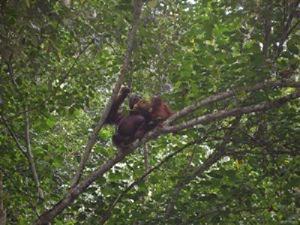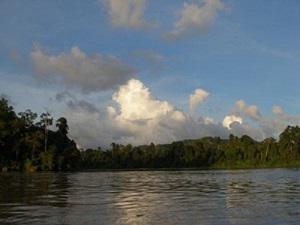Milena Salgado-Lynn
Assess the level of adaptive genetic variation of three primate species (orang-utan, proboscis monkeys and long-tailed macaques) within the LKWS and correlate it with specific environmental pressures such as their endoparasitic fauna.

Orangutan.
The Lower Kinabatangan Wildlife Sanctuary (LKWS) is renowned for its rich primate diversity. However as the habitat is highly fragmented, primate populations are suffering from environmental pressures that could lead them to extinction. Previous genetic studies on orang-utans, long-tailed macaques and proboscis monkeys have focused on neutral genetic variation, showing high levels of genetic diversity. Except for the long-tailed macaques, the populations seem to have undergone expansions and in the case of orang-utans this seems to correlate with anthropogenic mediated environmental change. Nevertheless, neutral markers do not provide information about the response to selective environmental pressures and the fitness of the populations.

Lower Kinabatangan Wildlife Sanctuary.
Therefore, it is important to assess the adaptive genetic variability of populations prior to direct intervention. MHC (Major Histocompatibility Complex) genes have been used as adaptive markers because they are essential for antigen recognition among other selective functions. Previous studies have shown that specific MHC alleles could be associated to resistance or susceptibility to infectious diseases in the wild. Some examples are the resistance to strongyle nematodes in Soay sheep (Ovis aries L.) and the resistance of Atlantic salmon (Salmo salar) to Aeromonas salmonicida due to variations in MHC class II alleles. For conservation purposes, it is urgent to find out whether there are immunogenetic variants that may influence susceptibility to pathogens.
By investigating the extent of MHC variation for species which have undergone population bottlenecks, such as proboscis monkeys and orang-utans, we can gain an indirect insight into their potential resistance against various diseases, which could be of great importance for the re-establishment of self-sustained populations. There are still very few studies examining the genetic basis of resistance to naturally occurring pathogens in wild vertebrate populations and this will be the first genetic study in the region to address adaptive genetic diversity of three primate species. The information will be used to identify adaptive genetic differentiation between sub-populations and threats to genetic diversity in order to determine appropriate intervention measures to maintain gene flow and diversity between these sub-populations.
The main objective is to compare neutral with adaptive genetic variation of three primate species (orang-utan, proboscis monkeys and long-tailed macaques) within the LKWS, and correlate the level of adaptive variation with specific environmental pressures such as their parasitic fauna. The results will be incorporated into the conservation management plan of these primates to ensure their long term-survival.